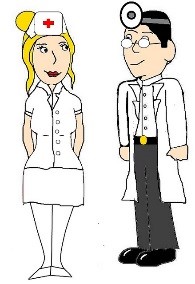Healthcare Workers
The main cause of infection in healthcare work settings is exposure to HIV-infected blood via a percutaneous injury (i.e. from needles, instruments, bites which break the skin, etc.
The average risk for HIV transmission after such exposure to infected blood is low; about 3 per 1,000 injuries (CDC, 2007). Certain specific factors may mean a percutaneous injury carries a higher risk, for example:
• A deep injury
• Late-stage HIV disease in the source patient
• Visible blood on the device that caused the injury
• Injury with a needle that had been placed in a source patient's artery or vein.
If percutaneous exposure occurs then the site of exposure should be washed liberally with soap and water but, without scrubbing. Bleeding should be encouraged by pressing gently around the site of the injury. It is important not to press immediately on the injury site and to cleanse wound under running water. Although infection through needle-stick injury does not often occur, it can be devastating for the person.
HIV has been acquired through contact with non-intact skin or mucous membranes (i.e. splashes of infected blood in the eye) in a small number of situations. Research suggests that the risk of HIV infection after mucous membrane exposure is less than 1 in 1000. If mucocutaneous exposure occurs then the affected area should be washed thoroughly with soap and water. If the eye is affected, it should be irrigated thoroughly.
If intact skin is exposed to HIV infected blood then there is no risk of HIV transmission.
TREATMENT AFTER EXPOSURE TO HIV
WHAT IS POST-EXPOSURE PROPHYLAXIS?
Prophylaxis means disease prevention. Post-exposure prophylaxis (or PEP) means taking antiretroviral medications (ARVs) as soon as possible after exposure to HIV, so that the exposure will not result in HIV infection. These medications are only available with a prescription. PEP should begin within as soon as possible after exposure to HIV but certainly within 72 hours. Treatment with 2 or 3 ARVs should continue for 4 weeks, if tolerated.
WHO SHOULD USE PEP?
Workplace exposure
PEP has been standard procedure since 1996 for healthcare workers exposed to HIV. Workers start taking medications within a few hours of exposure. Usually the exposure is from a "needle stick," when a health care worker accidentally gets jabbed with a needle containing HIV-infected blood. PEP reduced the rate of HIV infection from workplace exposures by 79%. However, some health care workers who take PEP still get HIV infection.
HOW IS PEP TAKEN?
PEP should be started as soon as possible after exposure to HIV. The medications used in PEP depend on the exposure to HIV. The following situations are considered serious exposure:
• Exposure to a large amount of blood.
• Blood came in contact with cuts or open sores on the skin.
• Blood was visible on a needle that stuck someone.
• Exposure to blood from someone who has a high viral load (a large amount of virus in the blood).
For serious exposures, the U.S. Public Health Service recommends using a combination of three approved ARVs for four weeks. For less serious exposure, the guidelines recommend four weeks of treatment with two drugs: AZT and 3TC.
WHAT ARE THE SIDE EFFECTS?
The most common side effects from PEP medications are nausea and generally not feeling well. Other possible side effects include headaches, fatigue, vomiting and diarrhea.
THE BOTTOM LINE
Post-exposure prophylaxis (PEP) is the use of ARVs as soon as possible after exposure to HIV, to prevent HIV infection. PEP can reduce the rate of infection in health care workers exposed to HIV by 79%.
PEP is a four-week program of two or three ARVs, several times a day. The medications have serious side effects that can make it difficult to finish the program. PEP is not 100% effective; it cannot guarantee that exposure to HIV will not become a case of HIV infection.
CDC guidelines on PEP are on the Internet. Occupational exposure: http://www.cdc.gov/mmwr/preview/mmwrhtml/rr5409a1.htm
Source: The AIDS Infonet
